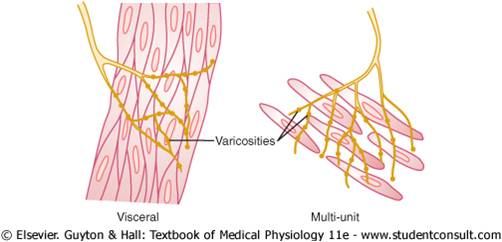
WEEK 3:SMOOTH MUCLE
Contractile Mechanism in
Smooth Muscle:
Chemical Basis for Smooth
Muscle Contraction--
Smooth muscle contains both actin and myosin filaments,
having chemical characteristics similar to those
of the actin and myosin filaments in skeletal muscle.
It does not contain the normal troponin complex
that is required in the control of skeletal muscle contraction,
so the mechanism for control of contraction
is different. This is discussed in detail later in this
chapter.
Chemical studies have shown that actin and myosin
filaments derived from smooth muscle interact with
each other in much the same way that they do in skeletal
muscle. Further, the contractile process is activated
by calcium ions, and adenosine triphosphate (ATP) is
degraded to adenosine diphosphate (ADP) to provide
the energy for contraction.
There are, however, major differences between the
physical organization of smooth muscle and that of
skeletal muscle, as well as differences in excitationcontraction
coupling, control of the contractile process
by calcium ions, duration of contraction, and amount
of energy required for contraction.
Physical Basis for Smooth Muscle Contraction:
Smooth muscle does not have the same striated
arrangement of actin and myosin filaments as is found
in skeletal muscle. Instead, electron micrographic techniques show large numbers of actin
filaments attached to so-called dense bodies. Some of
these bodies are attached to the cell membrane.
Others are dispersed inside the cell. Some of the membrane
dense bodies of adjacent cells are bonded
together by intercellular protein bridges. It is mainly
through these bonds that the force of contraction is
transmitted from one cell to the next.
Nervous and Hormonal Control
of Smooth Muscle Contraction:
Although skeletal muscle fibers are stimulated exclusively
by the nervous system, smooth muscle can be
stimulated to contract by multiple types of signals: by
nervous signals, by hormonal stimulation, by stretch of
the muscle, and in several other ways. The principal
reason for the difference is that the smooth muscle
membrane contains many types of receptor proteins
that can initiate the contractile process. Still other
receptor proteins inhibit smooth muscle contraction,
which is another difference from skeletal muscle.
Therefore, in this section, we discuss nervous control
of smooth muscle contraction, followed by hormonal
control and other means of control.


